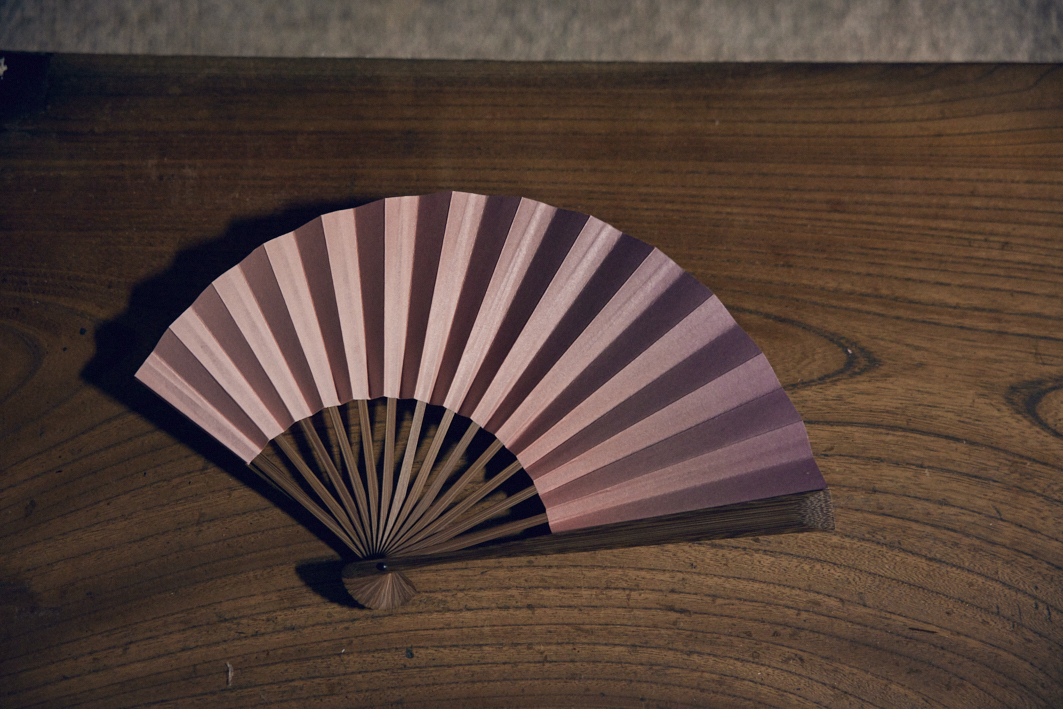Edogawa Craft Stories

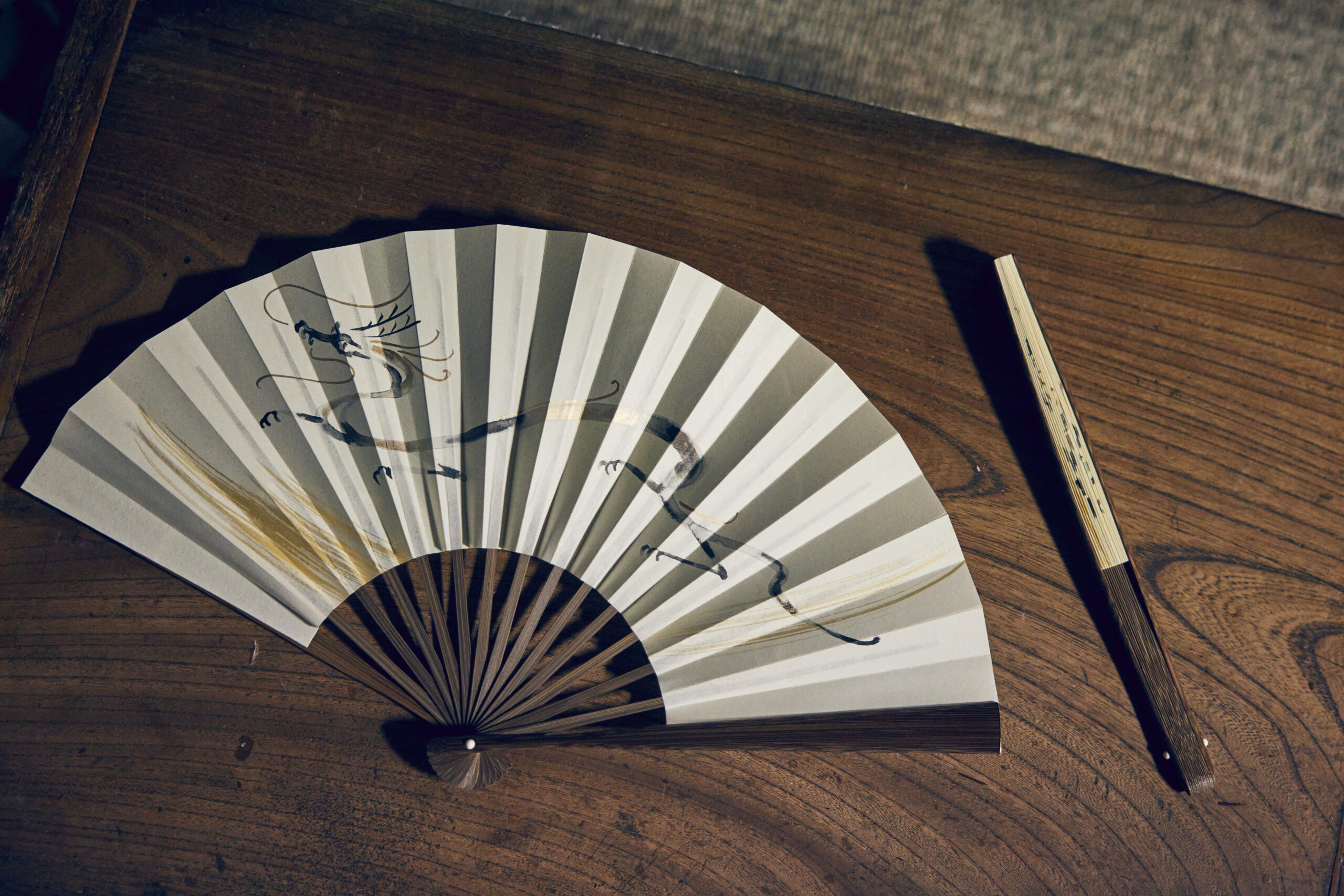
Edo-Native Aesthetics at Your Fingertips: Edo Sensu Born from Over 30 Processes
Edo Sensu – Matsui Sensu Kobo
Matsui Hiroshi
Nestled in a quiet residential area rich in nature, with the Edogawa River and Shinozaki Park just a stone’s throw away, stands the workshop of Edo sensu (folding fan) artisan Matsui Hiroshi. Past the lush garden, a lively banging sound rings out as we step inside. Matsui is in the middle of striking folded paper with a 30-cm wooden stick.
“This tool is called a hyoshigi,” he explains. “What I was just doing is called arauchi, one of the processes where I strike and press down the folded paper with the hyoshigi to shape it. If this part isn’t done properly, then later on when you open and close the fan, it won’t move smoothly.”
There are as many as 30 distinct steps involved in making an Edo sensu, and Matsui handles every one of them by himself.
.png)
Edo sensu artisan Matsui Hiroshi. He completes each of the 30 processes with rhythm and lightness.
When it comes to sensu, the traditionally crafted Kyo (Kyoto) sensu made in Kyoto is more widely known. However, the art of sensu was passed on to Edo during the Genroku era and developed with its own unique style. That tradition and skill continue today in the form of Edo folding fans.
“One of the clearest differences between Kyoto sensu and Edo sensu is the number of ribs,” Matsui says. “Even for fans of roughly the same size when opened, the number of ribs is completely different.”
Kyoto sensu typically have 25 to 35 ribs. With many folds, the spacing between creases is narrow, resulting in a delicate construction. Their elegant and ornate designs reflect the aesthetics of an aristocratic society. Edo sensu, by contrast, usually have 15 to 18 ribs. Developed in a samurai-centered Edo society, these fans are known for their practical, no-frills simplicity and stylish austerity.
Kyoto sensu are generally made through a division of labor, with several artisans contributing to the final product. Edo sensu, however, are crafted entirely by a single artisan through more than 30 individual steps.
“If you cut corners at any point, it will absolutely show up in some form in the finished piece. That’s why every single process matters, and you can’t lose focus. But that also means that when you finish a good fan, the sense of joy is all the greater.”
The distinctive snap sound made when closing the fan is another hallmark of Edo sensu. Matsui’s fans, in particular, are well known for this satisfying sound. For years, they’ve been beloved essentials for traditional dancers and rakugo comic storytellers alike.
“Each step is done with full attention and care,” says Matsui. The production process of an Edo sensu is a continuous flow of precise, delicate manual work, relying on subtle control of pressure and movement.
Take, for example, the hiraguchi ake step. After gluing three sheets of paper together, a spatula is used to split the middle layer into two, creating an opening through which the ribs will be inserted. Or the ori process, where the fan surface is folded accordion-style using two pattern sheets with pre-creased lines. Then there’s the nakazashi, in which bamboo is used to swiftly pierce through the paper from the opening at the edge, forming the path through which the ribs will pass.
“It’s really something anyone could do,” Matsui says with a self-effacing smile. But he handles each task swiftly and beautifully, the result of long years of experience and disciplined craftsmanship.
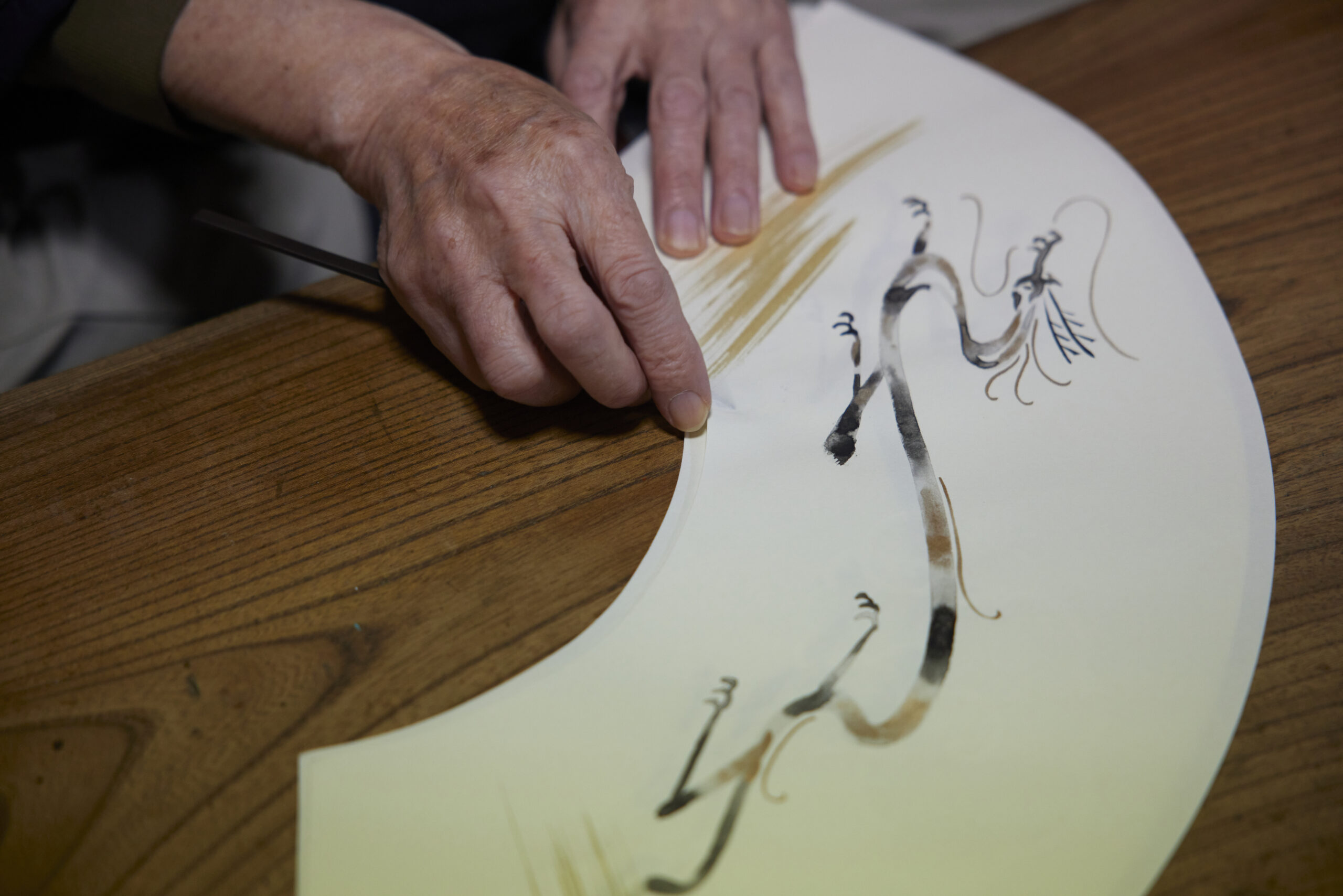
In the demanding hiraguchi ake process, the three layers of paper—so thin they’re nearly translucent—must be delicately split in the middle using a spatula.
.png)
In the ori process, all ten fingers move with dexterity and speed.
.png)
In the nakazashi process, a bamboo stick is inserted through the center of the hiraguchi to create a path for the ribs. If it bends or goes off-center, the ribs won’t fit in properly.
Matsui’s grandfather was also a fan maker, and his father—the previous generation—became independent in 1933 and built the current workshop in 1951, when Matsui was four years old.
“I’d watched my father working since I was small. By the time I was eleven, I was helping deliver sensu to our regular customers in places like Nihonbashi and Asakusa. You’d think they would be light, since they’re made of bamboo and paper. But when you have to carry tens or even hundreds of them, they become very heavy. And I was still little, so they felt even heavier. But I used to get a little extra for transportation costs, and I saved that as my spending money—it was something I really looked forward to.”
Matsui began following in his father’s footsteps about 60 years ago. At first, though, he didn’t particularly like making sensu.
“I’d grown up watching fan-making, so I had a vague idea of how it was done. But I wanted to see more of the world, so after graduating, I became a company employee. I quit after two or three years, though—it wasn’t for me. That’s when I started working at home.”
Even after beginning his apprenticeship under his father, he continued to struggle.
“I no longer had much interaction with people outside the workshop, and gradually I was overwhelmed by loneliness. Even while continuing my training, I spent nearly ten years wondering if this path was really right for me… and I still couldn’t find an answer.”
But little by little, Matsui began to feel something shift within himself.
“My father didn’t explain things in detail. It was a world of ‘watch and learn.’ So I constantly worked late into the night, trying to get even a little closer to the quality of his work. I made countless mistakes. But as I kept doing that, I started to enjoy the process of shaping something from nothing. Repeating the same task over and over, wanting to improve, wanting to become fully skilled—it gradually made me realize that this was the only path for me. I came to accept that, after all, this was my calling.”
If you look around the shelves lining the walls of Matsui’s workshop, you’ll find every surface covered with tools and materials used in sensu-making. Take just one example—the creasing stencils for the fan surface. Dozens of variations are stored here to accommodate different fan sizes, shapes, and fold widths. Even the bamboo sticks used to pierce the paper or the brushes for applying glue come in subtly different sizes and shapes. Most of these tools are handmade, and many have been passed down from his father’s generation.
-1.png)
A handmade tool with hand-written characters by Matsui’s father, the previous generation.
What Matsui pulled out next from beneath his workbench was a large, tree-stump-like wooden stand—said to be over a hundred years old. Looking closely, there are three distinct dents in its surface.
“This stand has long been used for a process called saki-tsumi, or tip-trimming, where we use pruning shears to trim and shape the oyabone—the outermost ribs of the fan. The dent closest to the front was made by my grandfather. He worked in the exact same spot for many years, and over time, the wood naturally wore down. The dent opposite that is where my father used to work. And the spot next to it—that’s my spot,” Matsui says with a laugh.
He then placed his hand on an untouched, unmarked section of the wood and grinned: “When the next person takes over, they’ll probably use this part.”
.png)
The 100-year-old wooden base used for the saki-tsumi process. The area with the light wood grain is the part currently used by Matsui.
Back when Matsui became a fully fledged artisan, there were about 20 Edo sensu craftspeople working in Tokyo. Today, the number has dwindled to just a handful. Amid this shrinking industry, Matsui continues to actively take part in demonstrations and workshops, hoping to inspire interest in Edo sensu among as many people as possible. At the same time, while preserving the integrity of tradition, he is also exploring new approaches to Edo sensu that align with modern lifestyles and needs. One example is the Gradation Sensu, developed in collaboration with Edogawa City. When unfolded, the fan reveals an asymmetrical shape—one side is visibly narrower than the other.
“In the summer, if you’re in a movie theater or a playhouse and you want to quietly take out your fan and cool off, the traditional wide shape might risk brushing up against the person next to you. But with this design, you don’t have to worry about that.” It’s a bold and clever innovation—a design that feels genuinely fresh.
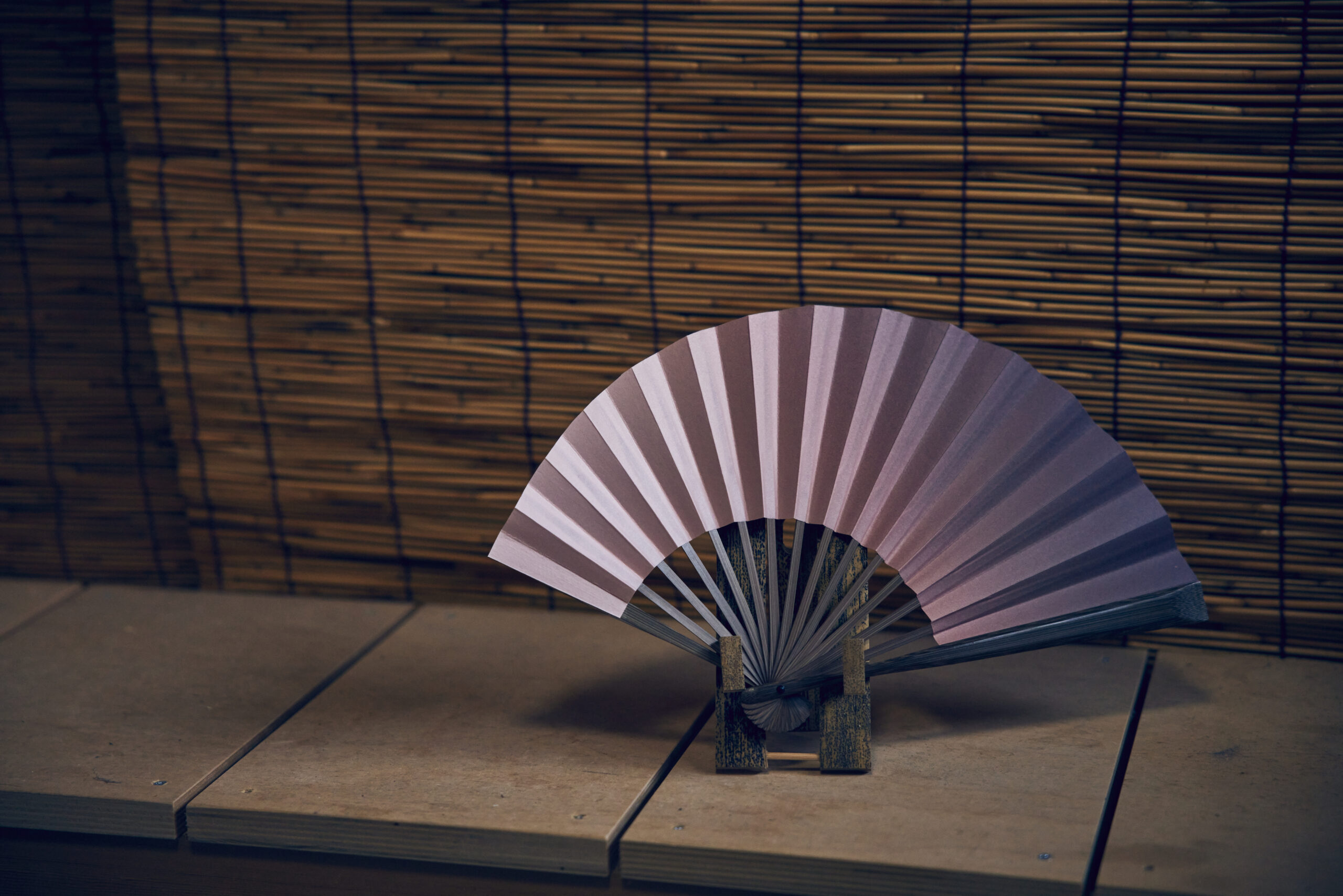
The EDO & TOKYO Gradation Sensu, developed through collaboration with students.
Matsui also participates each year in the Edogawa Traditional Crafts Industry, Academia, and Government Project, a collaboration that brings together the skills of Edogawa City’s traditional artisans and the creativity of art university students to develop new crafts.
“The students design the patterns and motifs, and I bring those designs to life. I tell them not to worry too much about traditional restrictions. If we impose too many limitations just because it’s a ‘traditional craft,’ it kills the students’ creativity. So I encourage them to think of it as creating a ‘new Edo sensu.’ In 2022, we made about 30 different fans. When the finished pieces arrive, I can clearly picture each student’s face—it brings a sigh of satisfaction.”
Between making fans, Matsui also finds time to visit nearby elementary schools to lead workshops. “I want young people to understand not only the techniques of Edo sensu but also the refined, understated elegance that’s embedded in something so simple. To do that, I can’t just keep doing the same things I always have. I want to create Edo sensu that will still be used far into the future.”
With his eyes on the future of Edo sensu, Matsui continues his work diligently and skillfully in his workshop, day after day.
Writing: Makino Yoko
Photos: Honna Yuka
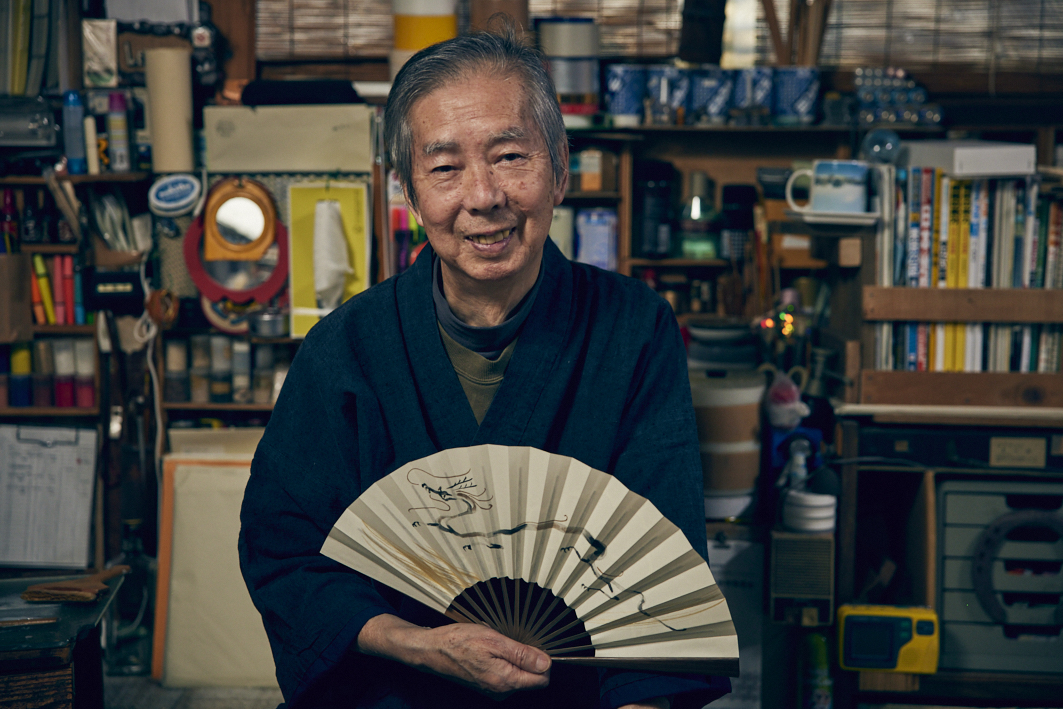
Introduction of the Artisan
Founded in 1951, Matsui Sensu Kobo specializes in Edo sensu, or folding fans, known for their simplicity and fashionable design which uses fewer ribs compared to Kyoto fans. Second-generation craftsman Matsui Hiroshi is the only Edo sensu artisan in Tokyo who single-handedly undertakes all 30 steps of the production process.
・Matsui Sensu Kobo
・2-24-3 Kitashinozaki, Edogawa-ku, Tokyo
